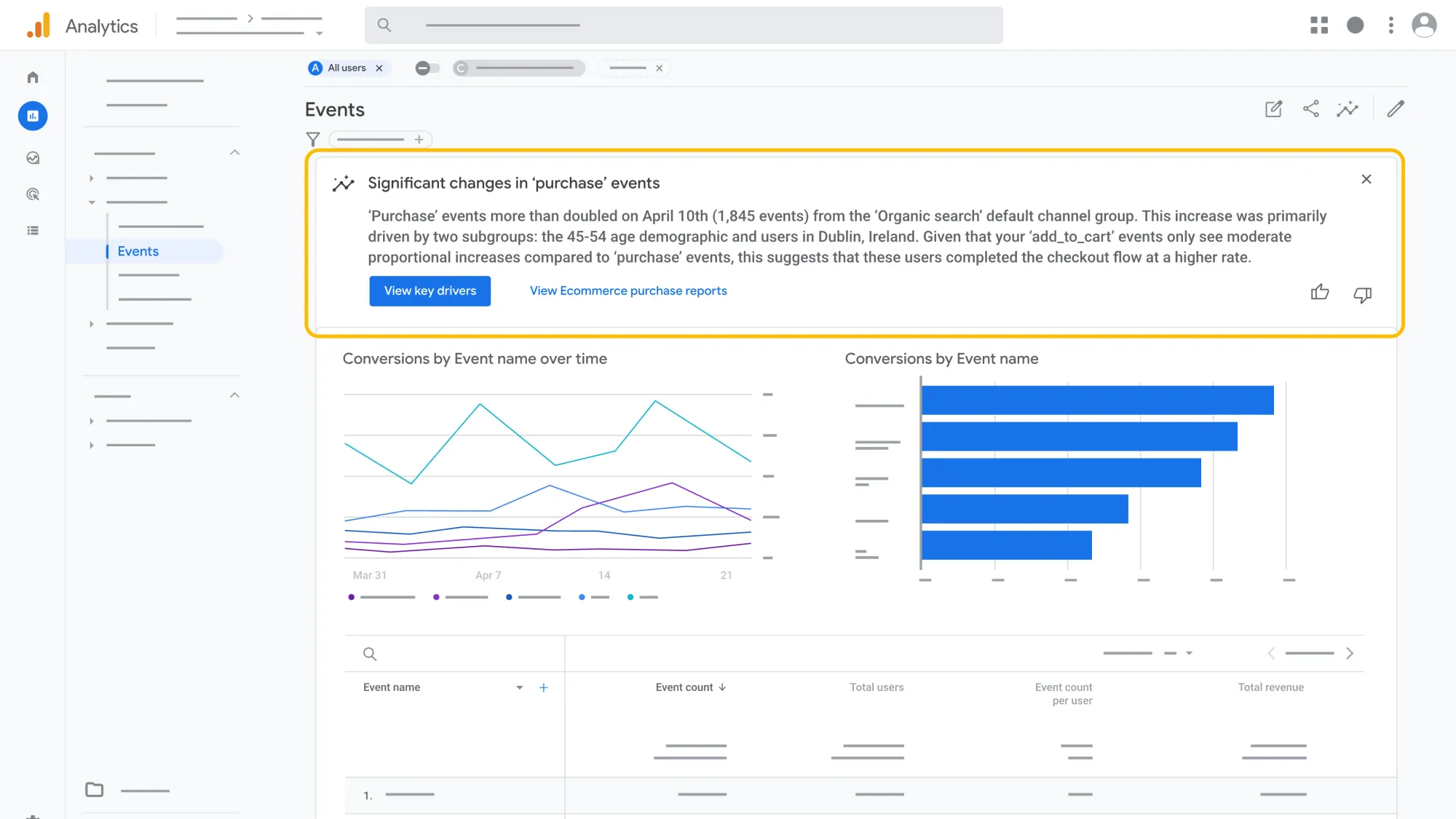Google Analytics enhances data analysis capabilities with April updates
Google introduces new filtering options and AI-powered insights to help analysts make sense of complex data.

Last week, Google Analytics introduced significant enhancements to its platform, expanding filtering capabilities and implementing new AI-powered features designed to streamline data analysis and decision-making processes for marketing professionals.
Additional match types for filters in Explore
On April 7, 2025, Google Analytics expanded its filtering capabilities within the Explore feature. According to the official announcement, "We've added support for all match types for item-scoped dimensions in 'Explore'. Additional match types are also available for the 'Audience' dimension in 'Explore'."
This technical improvement, which came just seven days ago, provides analysts with more granular control over data filtering when creating custom reports and explorations. The expanded match types enable users to create more precise segments for analysis, particularly when working with product or item-level data.
The enhancement addresses a long-standing limitation in the platform's exploration tools. Previously, analysts were restricted to basic match types when filtering item-scoped dimensions, which hampered their ability to perform sophisticated analyses of product performance and user interaction patterns.
For e-commerce businesses and companies with complex product catalogs, this enhancement significantly improves their capacity to identify specific performance trends at the item level. The addition of match types for the Audience dimension also enables more nuanced analysis of how different user segments interact with content and products.
Want to reach marketing professionals and decision-makers? Showcase your brand, tools, or services with our sponsored content opportunities.
Generated insights bring AI-powered analysis to detailed reports
Five days prior to the filtering enhancement, on April 2, 2025, Google Analytics launched a more substantial update to its reporting capabilities with the introduction of Generated insights in detailed reports.
According to the announcement, "Generated insights are now shown directly within detailed reports in Google Analytics to give you clear, concise summaries explaining fluctuations in your data in plain language."
The feature leverages artificial intelligence to analyze complex data patterns and present explanations in accessible language. As described in the documentation, "Imagine your 'Purchase' events spiked on a series of individual dates. Our AI engine works through the countless combinations of dimensions and metrics to proactively connect the dots, explaining why these spikes happened. These insights are written in a natural, easy-to-understand way, almost like a colleague summarizing the key takeaways for you."
The Generated insights feature appears at the top of detailed reports and includes call-to-action buttons that modify the report based on the insight provided, creating a more interactive analytical experience. This implementation represents a significant advancement in making data analysis more accessible to marketing professionals who may not possess extensive statistical expertise.
The new feature also includes a feedback mechanism. According to the documentation, "If Google Analytics surfaces a generated insight useful to you in a detail report, you can indicate it was helpful. Use the thumbs-up feedback button in the top right of the insight." Conversely, users can provide negative feedback for irrelevant insights or dismiss the insight banner entirely using the close button.
This feedback system is designed to improve the relevance of future insights. The documentation notes that "Based on your feedback, Google Analytics can better curate generated insights for you in the future."
Like what you're reading? Help us continue bringing you quality PPC news and insights by supporting PPC Land with a donation.
Understanding the significance for marketers
These April updates reflect a growing trend in marketing technology toward increased automation and intelligence in data analysis tools. The enhancements address critical challenges faced by modern marketing teams: the complexity of data analysis and the time constraints that limit deep analytical work.
The expanded filter match types in Explore provide particular value for marketing analysts working with complex product catalogs or detailed audience segments. For e-commerce marketers, the ability to filter item-scoped dimensions with more sophisticated match types enables more precise analysis of product performance across different user segments, potentially uncovering opportunities for inventory optimization and targeted promotions.
For marketing strategists, the Generated insights feature represents a significant advancement in democratizing data analysis. By automatically identifying patterns and explaining their significance in plain language, the feature reduces the expertise barrier to deriving actionable insights from marketing data. This has potential implications for team structures and skill requirements, potentially allowing marketing teams to operate more efficiently with fewer specialized analysts.
Campaign managers benefit from Generated insights' ability to identify causal relationships between marketing activities and performance fluctuations. The feature's capability to analyze "countless combinations of dimensions and metrics to proactively connect the dots" can reveal attribution patterns that might otherwise remain hidden in complex multi-channel campaigns.
The feedback mechanism incorporated into the Generated insights feature also represents an interesting application of human-in-the-loop machine learning. By collecting user feedback on the relevance and utility of insights, Google appears to be building a system that learns from user interactions to improve future analysis. This adaptive approach could potentially lead to increasingly personalized analytical support tailored to specific business contexts and user preferences.
Digital agencies and consultancies may need to reconsider their value proposition in light of these automated analytical capabilities. As platforms like Google Analytics incorporate more intelligent analytical features, the value of basic data interpretation services may diminish, pushing agencies toward more strategic advisory roles or specialized technical implementations.
Concerns and limitations
Despite the potential benefits, these updates raise questions about analytical transparency and control. The Generated insights feature, while making analysis more accessible, potentially obscures the underlying methodology used to identify patterns and correlations. This "black box" aspect of AI-powered analytics tools may create challenges for organizations that require transparent, auditable analytical processes.
There are also potential concerns around confirmation bias, as users might preferentially provide positive feedback for insights that align with their existing beliefs or hypotheses. This could potentially reinforce analytical blind spots rather than illuminating unexpected patterns in the data.
The reliance on machine learning algorithms also raises questions about how these systems handle edge cases or unusual data patterns. Marketing data often contains anomalies or context-specific patterns that may be difficult for automated systems to interpret correctly without domain knowledge.
Furthermore, while the expansion of filter match types in Explore enhances analytical capabilities, it also increases the complexity of the platform, potentially creating a steeper learning curve for new users. This complexity-capability tradeoff is a common challenge in analytics platforms seeking to balance power with accessibility.
Looking ahead: The future of marketing analytics
These April updates from Google Analytics highlight the accelerating trend toward intelligence augmentation in marketing technology. Rather than replacing human analysts, these features appear designed to enhance their capabilities by automating pattern detection and simplifying complex analyses.
The introduction of natural language explanations for data patterns signals a shift toward more conversational interfaces in analytics tools. This trend aligns with broader movements in technology toward more human-centric design that adapts to users' cognitive processes rather than requiring users to adapt to technological constraints.
For marketing professionals, staying current with these technological advancements becomes increasingly important. The competitive advantage once derived from technical mastery of analytics platforms may shift toward the ability to ask insightful questions and apply analytical findings in strategic contexts.
Organizations may need to reconsider their data governance and analytical workflows in light of these automated capabilities. Clear processes for validating and acting upon automatically generated insights will be essential to derive value from these features while maintaining analytical rigor.
As marketing analytics platforms continue to evolve, the relationship between human analysts and automated systems will likely become increasingly symbiotic. The most successful marketing organizations will be those that effectively combine technological capabilities with human creativity, domain expertise, and strategic thinking.
Timeline of Google Analytics updates in 2025
- January 13: Consent settings hub introduced to help manage consent signals across property streams
- January 21: Copy reports and explorations feature launched to facilitate configuration across properties
- February 3: Cost data import field requirements simplified, making campaign_name and campaign_id optional
- March 12: Percentage values added to report tables and notifications for missing data and high "not set" rates implemented
- March 20: Annotations feature introduced for line graphs in reports
- March 31: "(data not available)" value implemented for more accurate attribution
- April 2: Generated insights launched, providing AI-powered analyses in detailed reports
- April 7: Additional match types for filters in Explore added, enhancing filtering capabilities


